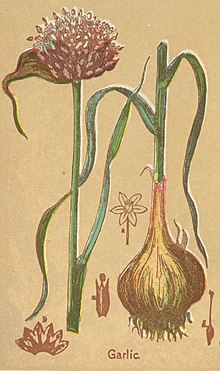
Native to central Asia and northeastern Iran, garlic is a herbaceous perennial and a member of the amaryllis family, Amaryllidaceae, that also includes onion, leek, and shallot. It was cultivated in Mesopotamia 4,000 years ago and was used in ancient Egypt as both a culinary and medicinal herb. The ancient Roman naturalist, Pliny the Elder (d 79 AD) notes the pungent flavor of raw garlic and the offensive smell it imparts to the breath. He goes on to describe 61 uses of garlic in remedies for ailments ranging from blisters, bites and stings to asthma, jaundice, and madness. Sacred to Mars, the god of War, garlic was eaten by Roman soldiers to give them strength and endurance but was not widely used as a culinary herb as it is in modern Italian cuisine. Garlic grows in Pompeii today and epigraphical evidence suggest that it was also bought and sold in ancient Pompey. Photo Credit Wikipedia
Description: Growing from a bulb consisting of up to 20 cloves, the plant has 6-12 linear, flat, grass-like leaves up to 2′ long with a pointed tip. From July to September the bulb may produce a flowering stem up to 3′ tall carrying an umbel with pink to purple flowers surrounded by a brown sheath.
Height: 12-18″
Light: Full sun
Soil: Average, medium moist, well-drained
Hardiness: USDA Hardiness Zones 3-10